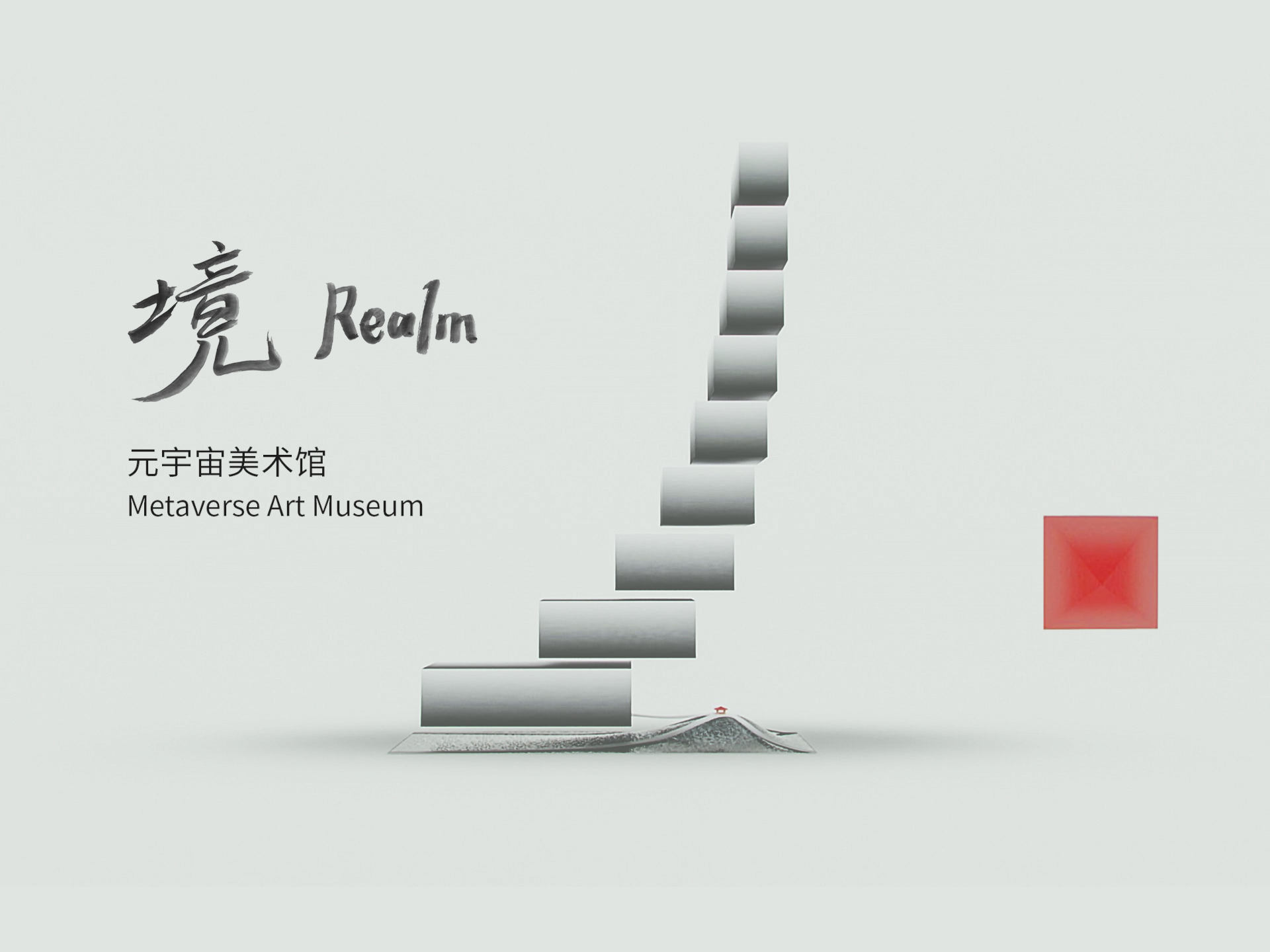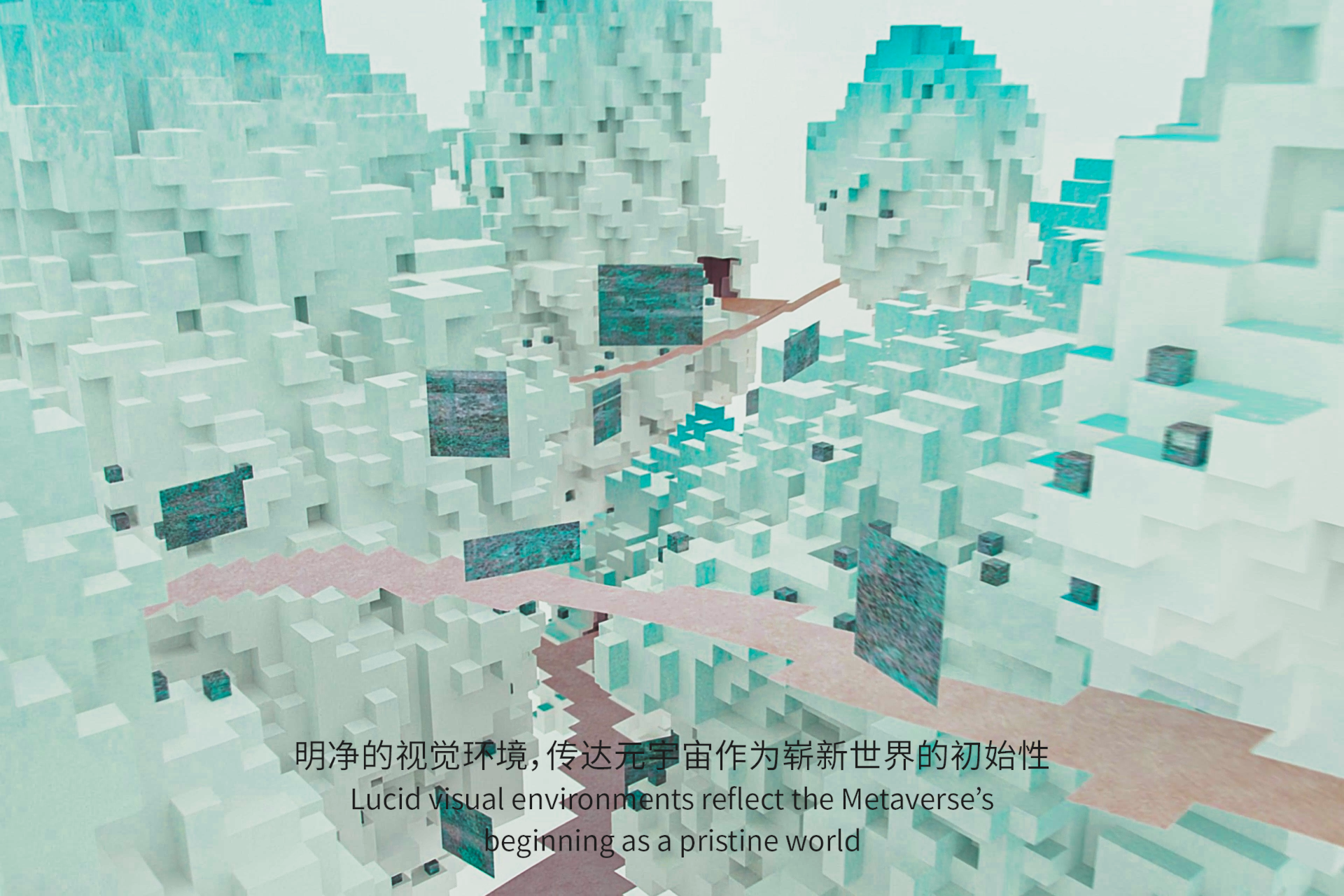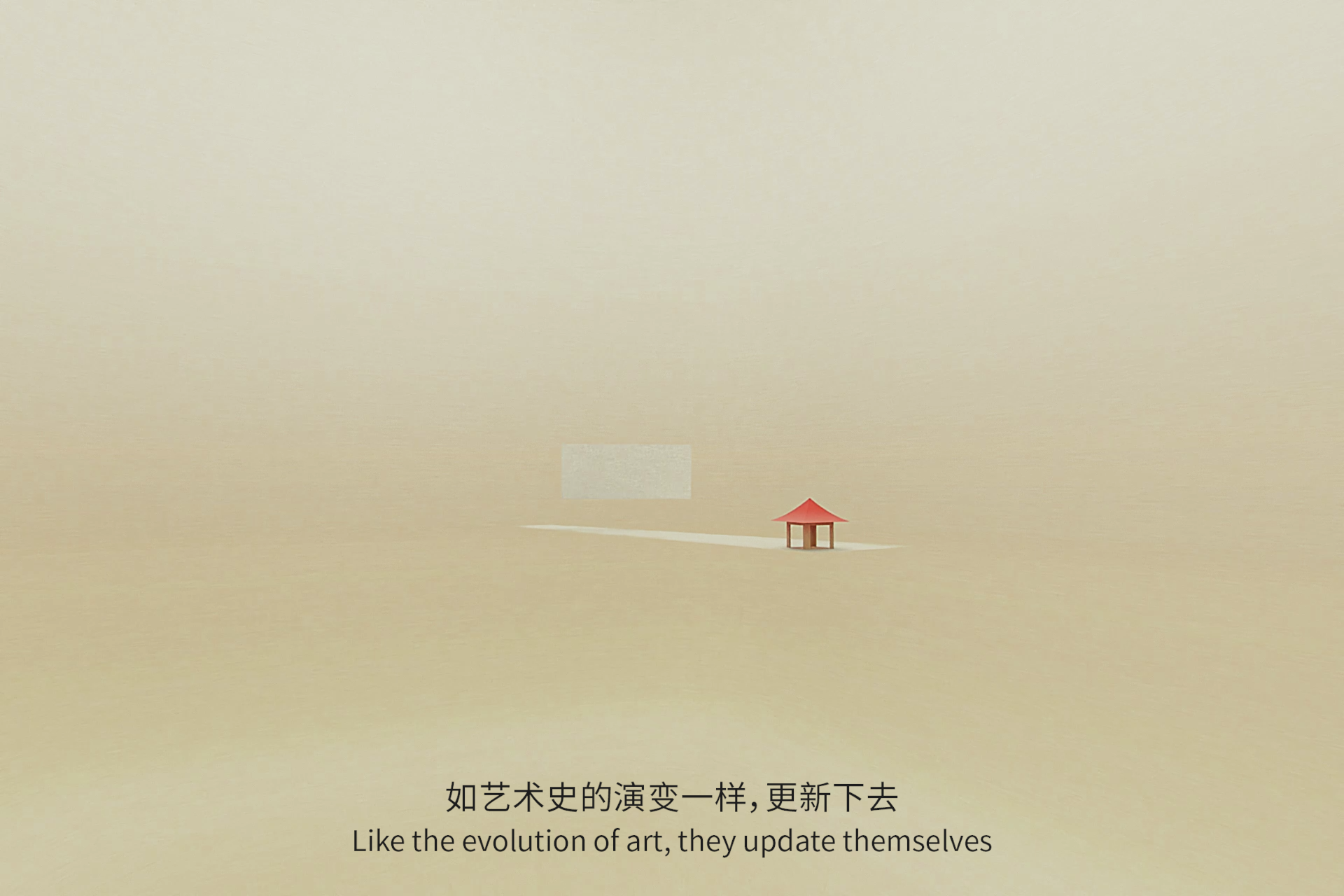Realm: Metaverse Art Museum
境 :元宇宙美术馆
March 2022
Virtual architectural design
Competition Entry
A metaverse art museum design by Duyi Han is named finalist in an international competition for Fengyuzhu Digital Art Museum on Baidu's metaverse platform Xirang. This is the first competition held in China for metaverse architectural design. Among more than 600 entries, 20 are named finalists. Judges include: Wu Zhiqiang (Member, Chinese Academy of Engineering), Patrik Schumacher (Zaha Hadid Architects), Ma Yansong (MAD Architects), Shao Zhong (Founder, Meta Media Group), Ma Jie (Vice President, Baidu), Duan Zhiyun (Vice President, Roblox China), Li Xiangning (Tongji University), Philip Tinari (Director, UCCA), Yuan Feng (Tongji University), Song Ting (NFT artist).
Level by level, every realm of landscape can hold an entire world.
What can a Chinese narrative be for a Metaverse art museum?
Ancient Chinese painters and scholars usually pursue an idealist spiritual journey beyond material appearance. In classical landscape painting, from the foreground at the foot of the mountain, step by step to the midground up the hills, then toward the mountain peak farther away, this procession is a visual projection of the spiritual journey. Seeing contemporary art is a journey of a dialogue with the mind and the spirit. Therefore, the design of the art museum references the landscape painting narrative, while in its execution paying homage to virtual gaming’s experiential design of having a different landscape after every game level. In the midst of the extravagant Metaverse cityscape, above glistening waves, float a stack of Judd-like ink-colored minimalist cuboids. Level by level, every cuboid is a piece of canvas, every realm of landscape can hold an entire world.
In the Metaverse, how is architecture and its style liberated? How does beauty activate feelings with new possibilities?
From simple, to elaborate, then back to simplistic but nuanced, is a universal evolution cycle of the formal style of architecture, art, and design. Every level’s landscape comes from fundamental formgiving techniques that have appeared and reappeared in the history of architecture, art, and design. From start to end, between the most extravagant and the most austere, exist endless possibilities. In the Metaverse, architecture shifts from physical funtion-driven to visual environment-driven. It unleashes itself from the intricacies of physical structure, construction budget, safety regulations, circulation, and program, and becomes a purer aesthetic experience. From the White Box of the first level, to the increasingly complex, increasingly dynamic, and increasingly anti-gravity superstructures of the following levels, back to the smaller landscapes of the later levels with more humble forms but more subtle details, and to the minimalistic but immersive last level, the diversity of space allows for the diversity of artworks and happenings. Although the forms of each landscape seem to ambiguously reference some familiar architectural, natural, or cultural symbols, they are rather abstract and independent and don’t deliberately imitate real material textures. Through examining the Metaverse’s unique properties, I choose to use these lucid visual environments to reflect the state of beginning of the Metaverse as a new pristine world. I use the diversity of form, color, and explorative paths to activate the visitors’ emotion and feeling.
Between architecture, exhibition design, artworks, and visitors, how are the relationships and roles?
In physical reality, it is difficult to construct bespoke exhibition environments for every new exhibition, and so the architectural shell of art museums bear the role of being an iconic scene. In the Metaverse, this role can easily migrate to bespoke scenes, and the bespoke scenes can update without limit. A perfect art museum should not have just one single style of space dictated by one architect. A Metaverse art museum itself does not need permanent architecture, exhibition design, and program setup. Instead, it can give freedom to content, to art, culture, and technology, and let curators, exhibitiors, and participants empower unlimited richness. Thus, the Metaverse art museum is iconic in its inner experience. I consider the scenes I design here as the starting samples on a canvas. They manifest art history, and like the evolution of art history, they will update themselves. In these scenes, artworks can release themselves from walls, floors, fixed positions, and fixed sizes, exist in any form, and even can be intersected by visitors. The scenes can have no direct relationship with exhibited content and information, or become the direct medium of content and information display, thus being the artwork. The visitors—virtual avatars—as the visual mediation between the physical person and the virtual art space, are themselves visual expressions. They are both cameras and screens, both audiences and performers. The museum is both a vessel for art, and a stage for people.
由Duyi Han设计的元宇宙美术馆方案入围了百度希壤元宇宙平台风语筑元宇宙数字艺术馆全球竞赛。该竞赛是国内元宇宙虚拟建筑设计的首次招标活动,共有600余组报名,20个入围方案。评委包括:吴志强(中国工程院院士)、Patrik Schumacher (Zaha Hadid Architects)、马岩松 (MAD Architects)、邵忠(现代传播集团创办人)、马杰(百度副总裁)、段志云(Roblox副总裁)、李翔宁(同济大学建筑与城市规划学院院长)、田霏宇(UCCA尤伦斯当代艺术中心馆长兼CEO)、袁烽(同济大学建筑与城市规划学院教授、博导)、宋婷(AI和区块链艺术家)。
层层递境,每一隅山水都可以装下一整个世界。
元宇宙的美术馆可以有怎样的中国式叙事?
古代的中国画家和文人,大多在外表之外追求理想的精神之旅。山水画中,从山下的前景一步一步漫游到山腰,再去往远处顶峰,是理想精神之旅的视觉投射。鉴赏当代艺术是一个和精神世界对话的旅程。因此美术馆的设计参考了山水画的叙事过程,同时在实现方式上致敬虚拟游戏中的每通一关就是一个不同世界的体验模式。在争奇斗艳的元宇宙城市景观里,一列Judd感的极简水墨色长方体,呈阶梯式悬浮于波光之上。层层递境,每一个长方体都是一片画布,每一隅山水都可以装下一整个世界。
在元宇宙,建筑和建筑风格获得什么样的解放?美,如何用新的可能性来调动情绪?
从简单,到繁杂,再回归简约而微妙,是建筑、艺术、设计视觉造型风格的普遍变化规律。每一层的场景都源于世界建筑史、艺术史、设计史中不断循环往复出现过的基本赋形手法。从初始到尽头,介于至繁与至简之间,是无限的可能性。在元宇宙中,建筑从物理功能导向转变为视觉环境导向,从结构、造价、安全规范、行走动线、功能划分的限制中解脱出来,成为更纯粹的美学体验。从第一层的“白盒子”,到之后几层的越来越复杂、越来越有动感、越来越脱离重力的超级结构,再到回归朴实但又有细腻细节的更小的场景和简约的结尾,多样的空间容纳多样的艺术品和发生的事情。各个场景造型似乎在暧昧地参考某种熟悉的建筑、自然或文化符号,但又足够抽象独立,也没有刻意模拟真实世界的材质。通过对元宇宙自身独特属性的思考,我选择用这些明净的视觉环境来传达元宇宙作为一个崭新世界的初始性,用形状、颜色、探索路线的多样性来调动参观者的情绪和感受。
建筑、布展、艺术品、参观者之间的关系和角色可以是怎样的
在物理现实中,每次都要为展出内容定制的场景不易搭建,因此美术馆建筑外壳担当了标志性场景的角色。但在元宇宙,这个角色可以容易地转移到展览的定制场景上,而且场景可以无限更新。一个理想的美术馆,不应只有一种由建筑师主宰的单一空间风格和设置。元宇宙的美术馆,本不需要常在的建筑、展览、活动布置,而是可以把自由度交给内容,让艺术、文化、科技, 让策展人、参展者、参与者,在空间里赋予充实内涵。元宇宙美术馆的标志性,便在于这内在体验。我将这次在这里设计的场景看作画布上的初始例子,既是对艺术史的折射,又如艺术史的演变一样,会更新下去。在这么多的场景上,艺术品可以脱离展墙、地面、固定不动的位置、固定不动的大小,以任何空间形式存在,甚至可以被参观者直接穿过。场景既可以与展览的内容信息没有直接关联,也可以是内容信息的显示媒介,成为内容本身。真人参观者的虚拟角色,作为真人和虚拟美术空间之间的视觉中介,本身也是视觉表达,既是镜头,也是屏幕,既是观众,也是表演者。美术馆既是艺术的容器,也是人的舞台。
Duyi Han, March 2022
Competition result 比赛结果 (Archdaily China)


















